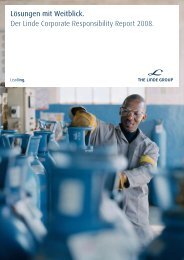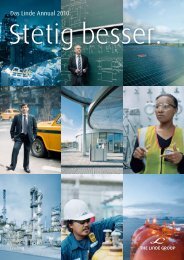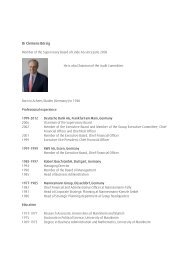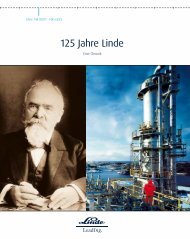The complete history of the development of The - The Linde Group
The complete history of the development of The - The Linde Group
The complete history of the development of The - The Linde Group
Create successful ePaper yourself
Turn your PDF publications into a flip-book with our unique Google optimized e-Paper software.
18<br />
1888<br />
N o 0037 Process and<br />
device for defrosting air cooling tubes.<br />
Wilhelm II becomes Kaiser <strong>of</strong> <strong>the</strong> German Empire.<br />
Business model and early internationalization:<br />
factors for success<br />
A number <strong>of</strong> factors underlie Carl von <strong>Linde</strong>’s success in developing<br />
his young business into Germany’s leading international<br />
supplier <strong>of</strong> refrigeration machines within just ten years:<br />
<strong>The</strong> business model. As an entrepreneur, Carl von <strong>Linde</strong> relied<br />
from <strong>the</strong> very start on close cooperation with potential users <strong>of</strong><br />
his technology, above all beer brewers. In production he relied<br />
in turn on a few machinery manufacturing companies. But von<br />
<strong>Linde</strong> insisted that only his engineers, assemblers and installers<br />
would install and start up <strong>the</strong> machines at <strong>the</strong> customers’ facilities,<br />
thus ensuring direct and exclusive contact with <strong>the</strong> customers.<br />
Loyalty. One <strong>of</strong> von <strong>Linde</strong>’s closest confidants was Heinrich von<br />
Buz, <strong>the</strong> director <strong>of</strong> Maschinenfabrik Augsburg (later MAN). Over<br />
<strong>the</strong>ir entire business relationship <strong>of</strong> 50 years or so, von Buz sat on<br />
<strong>the</strong> <strong>Linde</strong> Supervisory Board for 39 years. In <strong>the</strong> Sulzer bro<strong>the</strong>rs<br />
von <strong>Linde</strong> found highly competent people to turn to for technical<br />
problem-solving. Von <strong>Linde</strong> also had <strong>the</strong> Sulzer connection to<br />
thank for <strong>the</strong> fact that his company became <strong>the</strong> largest supplier<br />
<strong>of</strong> refrigeration machines for <strong>the</strong> meat industry in Argentina.<br />
Personnel policies. Over <strong>the</strong> years, von <strong>Linde</strong> preferred to hire<br />
graduates <strong>of</strong> <strong>the</strong> Technical University <strong>of</strong> Munich whom he knew<br />
personally or who were recommended to him by his teaching<br />
successor at <strong>the</strong> university, Moritz Schröter. Friedrich Schipper,<br />
Robert Banfield, Rudolf Diesel (see also page 38), Karl Heimpel,<br />
Hermann Reu<strong>the</strong>r, August Krebs and Alexius Negele, among o<strong>the</strong>rs<br />
were all alumni <strong>of</strong> TC Munich. Von <strong>Linde</strong> also relied on family<br />
members. During <strong>the</strong> early years, two <strong>of</strong> his bro<strong>the</strong>rs and a<br />
bro<strong>the</strong>r-in-law worked for <strong>Linde</strong>’s company. <strong>The</strong>y were followed<br />
by two nephews, two sons-in-law and two <strong>of</strong> his own sons,<br />
physicist Friedrich and engineer Richard <strong>Linde</strong>, who, toge<strong>the</strong>r<br />
with <strong>the</strong>ir bro<strong>the</strong>r-in-law Rudolf Wucherer largely determined<br />
<strong>the</strong> fortunes <strong>of</strong> <strong>the</strong> company through <strong>the</strong> middle <strong>of</strong> <strong>the</strong> 20th<br />
Century (see also page 45).<br />
Compensation. In order to create <strong>the</strong> strongest possible ties<br />
between his key people and <strong>the</strong> company, von <strong>Linde</strong> paid<br />
above-average salaries. Head engineers could earn between<br />
15,000 and 20,000 marks per year including pr<strong>of</strong>it sharing during<br />
<strong>the</strong> 1890s. Unlike <strong>the</strong> engineers, for a long time <strong>the</strong> commercial<br />
employees in <strong>the</strong> company did not play an especially<br />
major role. It is a telling fact that prior to <strong>the</strong> Second World War<br />
no commercial employee was ever appointed to <strong>the</strong> company’s<br />
Executive Board.<br />
Early internationalization<br />
N o 0043 Refrigeration<br />
systems for crystallization from brine.<br />
For decades <strong>Linde</strong>’s first production partners remained his most<br />
important ones, such as Maschinenfabrik Augsburg and Gebrüder<br />
Sulzer in Winterthur, Switzerland. However, because <strong>of</strong> differing<br />
patent regulations in each country, <strong>the</strong> size <strong>of</strong> <strong>the</strong> markets and<br />
for reasons <strong>of</strong> caution, <strong>the</strong> number <strong>of</strong> license partners within<br />
and outside Germany quickly rose, which didn't always appeal<br />
to <strong>the</strong> company's most important business colleagues.<br />
France<br />
In France, after a few detours and false starts, von <strong>Linde</strong> established<br />
a relationship with Satre & Averly <strong>of</strong> Lyon in 1877. This<br />
company also built <strong>the</strong> first machine in order to secure <strong>the</strong><br />
French patent. But after <strong>the</strong> founding <strong>of</strong> <strong>the</strong> <strong>Linde</strong> Company,<br />
shareholder Moritz von Hirsch took over <strong>Linde</strong>’s patents in<br />
France and founded <strong>the</strong> “Société pour la production de glace et<br />
d’air froid d’après le système <strong>Linde</strong>.” Business, however, was<br />
unsatisfactory, so von <strong>Linde</strong> bought <strong>the</strong> license rights back from<br />
this major shareholder in 1890 and awarded <strong>the</strong>m to <strong>the</strong> CAIL<br />
company.



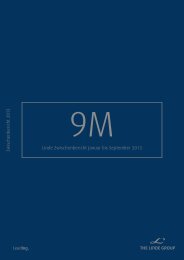
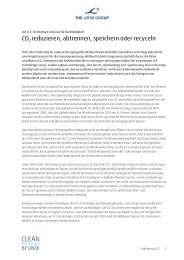

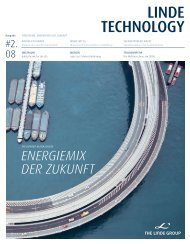
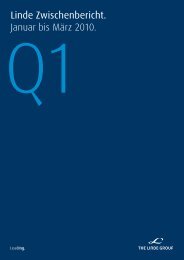
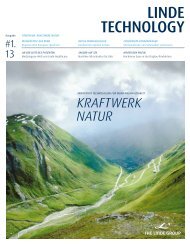

![[41] Anteilsbesitzliste des Linde Konzerns und ... - The Linde Group](https://img.yumpu.com/8356102/1/184x260/41-anteilsbesitzliste-des-linde-konzerns-und-the-linde-group.jpg?quality=85)
![[41] Anteilsbesitzliste des Linde Konzerns und ... - The Linde Group](https://img.yumpu.com/8356076/1/184x260/41-anteilsbesitzliste-des-linde-konzerns-und-the-linde-group.jpg?quality=85)
